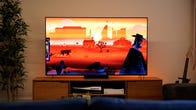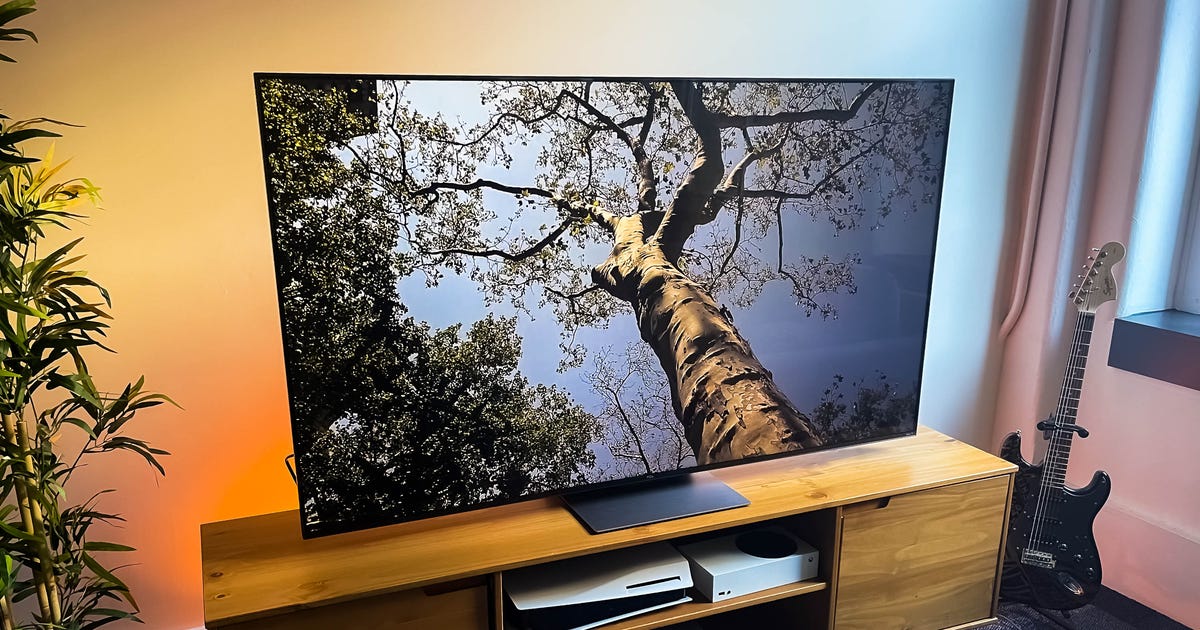
Over the last five years the TCL 6-Series has earned its place as the best TV for the money by combining excellent image quality with a price most TV shoppers can afford. The latest version does pretty much exactly the same thing. Although its competition is even stronger this time around, the TCL 6-Series Roku TV still prevails as my favorite in the midtier price range — roughly a grand for a 65-inch size.
Like
- Relatively affordable Excellent overall image quality Roku smart TV is simple, capable Improved design with central stand
Don’t Like
- Some competing mini-LED TVs can get brighter
You can definitely spend more on a TV. If you do that, though, you might as well go all in on an OLED model like the LG C2. And some slightly cheaper models, like the Vizio MQX, are excellent too. But if you prioritize picture quality, I think it’s worth paying more for this TCL instead.
Among 2022 TVs I’ve tested, the 6-Series’ closest competitor is the Hisense U8H, the only other TV in this price range with mini-LED technology. In my side-by-side comparison I found the Hisense brighter and more dynamic, and therefore a better choice for very bright rooms than the TCL 6-Series. On the other hand its home theater image isn’t quite as accurate or refined as the TCL, which is still incredibly bright itself. And if you care about built-in smart TV systems, it’s worth noting the TCL has Roku, which I prefer to Google TV on the Hisense.
As always there are plenty of other TVs to choose from, but if you want my advice for the best picture quality and features at the best price, it’s once again the TCL 6-Series.
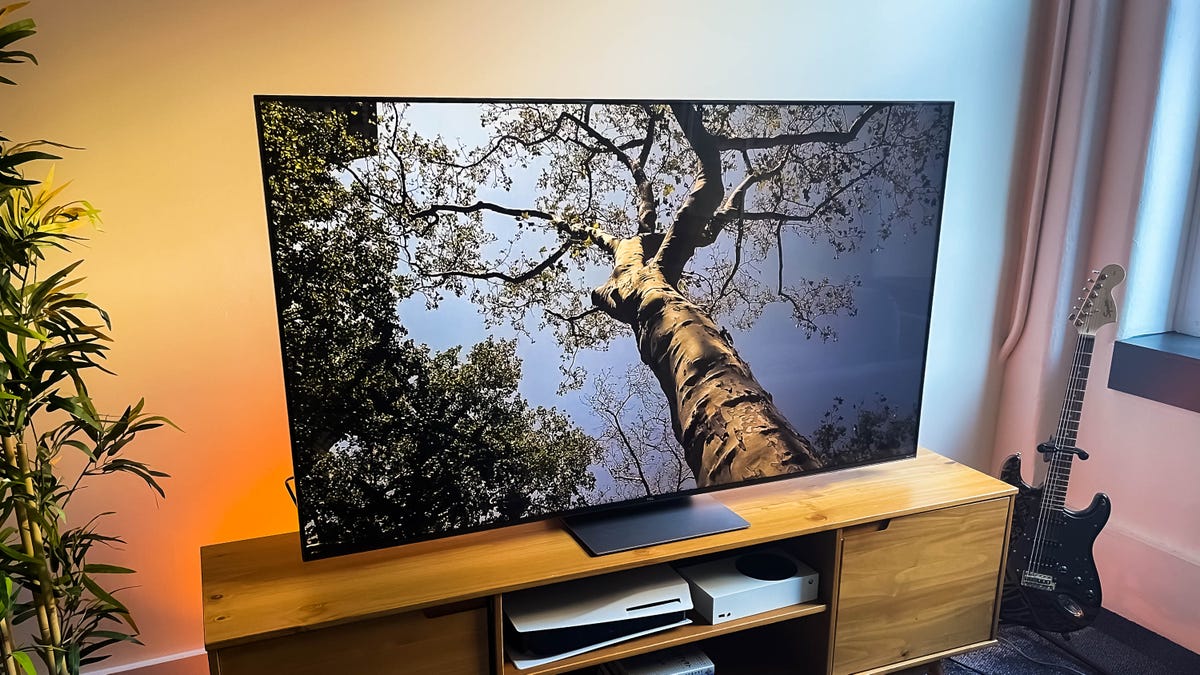
The TCL 6-Series Roku TV, seen here at 65 inches, also comes in 55-, 75- and 85-inch versions.
David Katzmaier/CNET
TCL 6-Series sizes
I performed a hands-on evaluation of the 65-inch 2022 TCL 6-Series (the R655 series), but this review also applies to the other screen sizes in the series. Aside from different numbers of local dimming zones, detailed below, all sizes have similar specs and should provide similar picture quality.
- TCL 55R655, 55-inch
- TCL 65R655, 65-inch
- TCL 75R655, 75-inch
- TCL 85R655, 85-inch
In addition to the older TCL 6-Series Roku TV (the R635 series), which the R655 replaces, other versions of the 6-Series were released in 2021 and remain on sale. The R646 series uses the Google TV operating system but otherwise has similar specifications to the R655 models reviewed here. The R648 series has 8K resolution and is significantly more expensive. We haven’t reviewed either one.

A center stand looks nicer and fits on narrower pieces of furniture than stands that consist of separate legs.
David Katzmaier/CNET
Sleeker look, adjustable center stand
The most conspicuous upgrade for the TCL 6-Series in 2022 is the new stand design. It’s a central pedestal, which I think looks nicer than a pair of feet mounted at the edge, and also allows you to use a narrower TV stand if you want. The dark silver metallic base matches the strip running around the edge of the panel, and like most TVs the 6-Series looks like it’s nearly all picture, with just a thin frame.
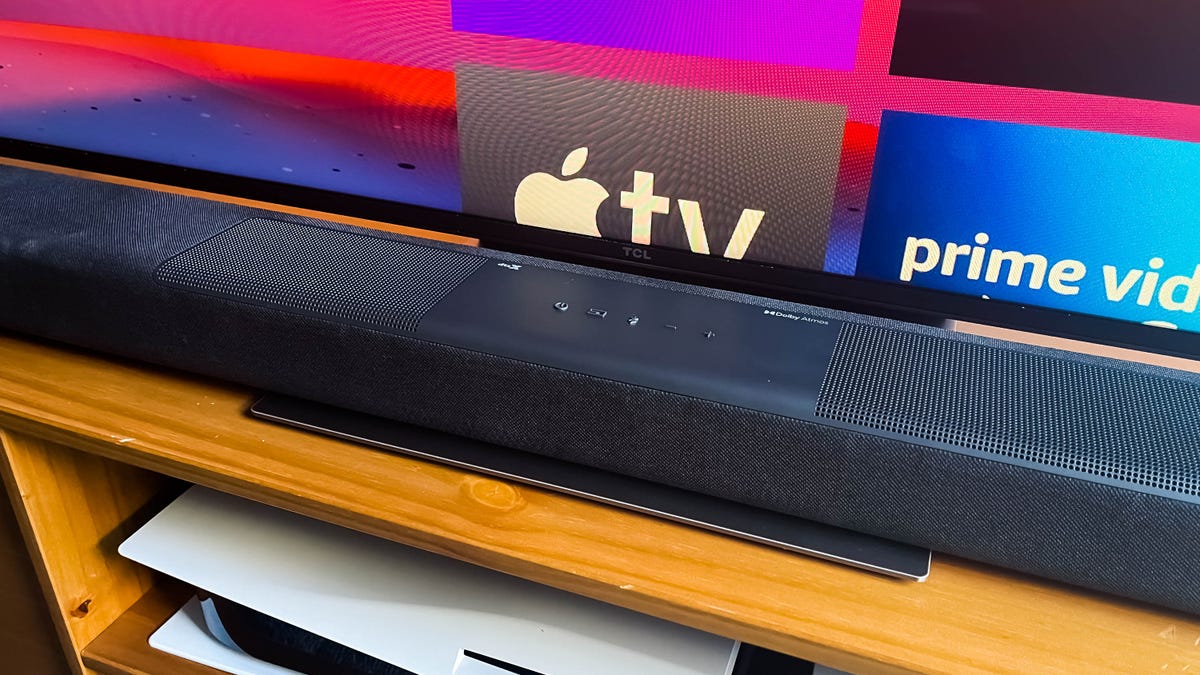
The TV stand can raise the panel a few inches so a soundbar doesn’t obstruct the screen.
David Katzmaier/CNET
Another welcome addition is the ability to adjust the TV higher or lower relative to the stand. Setting it higher creates a gap that allows you to put a soundbar in front without obscuring the screen.

David Katzmaier/CNET
The 6-Series includes the simple Roku remote with built-in voice control. Roku’s voice function isn’t nearly as robust as Amazon Alexa or Google Assistant, for example, but it worked fine for searches, app launching, switching inputs and tuning to an antenna channel. If the TV is off, a voice command such as “Launch Netflix” will turn it on and launch the app.
Smart TV simplified with Roku
Streaming on the TCL 6-Series reminded me why I continue to prefer Roku TV over any of its competitors: simplicity and lack of clutter. Pretty much all of the others, including Amazon Fire TV, Google TV, Vizio, Samsung and LG, pack the screen with lots of shows, movies and promotions I don’t want, as well as persistent menus with lots of choices and add-ons. Roku, just like an iPhone, is still basically just a grid of apps I can add, remove and rearrange to my liking. Sure there’s a big ad to the side, but I prefer that to a carousel of ads and show promotions in the middle.

Roku allows numerous customizations, including theme packs like Western.
David Katzmaier/CNET
Google TV is my second-favorite and has its advantages, including better voice support, a convenient “Continue Watching” section and quick access to shows within apps. But for me, Roku’s speed and simplicity win out. Operation wasn’t flawless, however. At one point while exploring the LIve TV section I clicked favorite channels and the whole TV froze and wouldn’t respond to any commands. The only solution was to pull the plug.
Features: Mini-LED for minimal money
The big difference between the 6-Series and cheaper LCD-based TVs is its mini-LED backlight. Mini-LEDs are, as you might have guessed, smaller than standard LEDs, allowing them to be grouped into more local dimming zones. Full-array local dimming is the best way to improve picture quality on LCD TVs. It allows the screen to dim and brighten different areas simultaneously. Smaller areas, or more dimming zones, mean more precise illumination — which ultimately increases contrast, the most important ingredient in a good picture — but they’re not the only factor. Here’s how the TCL’s zone count stacks up with the 2022 Hisense and Vizio TVs I compare below.
Local dimming zones compared
| TCL 6-Series | Hisense U8H | Vizio MQX | |
|---|---|---|---|
| 50-inch/55-inch | 204 | 338 | 16 |
| 65-inch | 288 | 504 | 30 |
| 75-inch | 360 | 528 | 42 |
| 85-inch | 448 | N/A | N/A |
The 6-Series has a true 120Hz refresh rate, which leads to better motion performance. Like most TVs in its class today the 6-Series uses quantum dots that help improve color compared to non-QD-equipped TVs. And of course it supports both Dolby Vision and HDR10 high dynamic range (HDR) formats. These days basically the only manufacturer that doesn’t is Samsung. The 6-Series also adds Dolby Vision IQ, which works with an ambient light sensor to automatically adjust the picture.
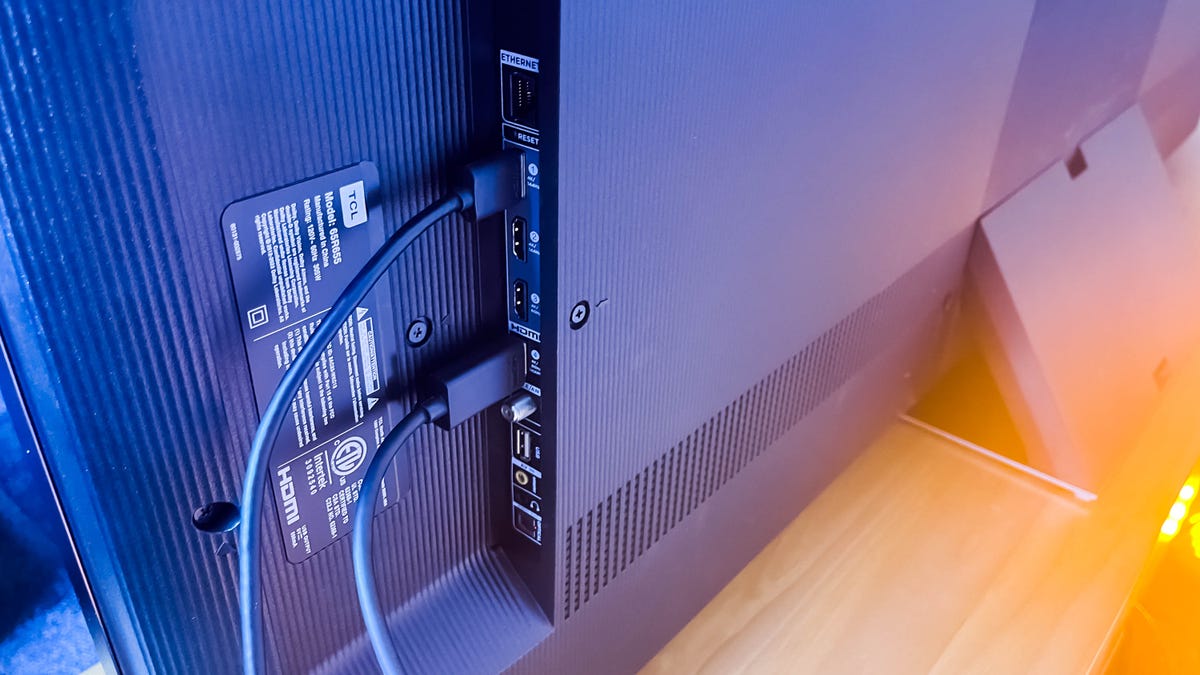
David Katzmaier/CNET
- Four HDMI inputs (two with 4K/120Hz, one with eARC)
- Analog (composite) video input
- USB port (2.0)
- Ethernet (wired internet)
- Headphone jack
- Optical digital audio output
- RF (antenna) input
The biggest step-up in connections compared to the earlier TCL 6-Series Roku TVs is the ability to accept 4K/120Hz input signals, from an Xbox Series X or PlayStation 5, for example. The TV is actually capable of 144Hz input, according to TCL, but that extra bit of refresh isn’t a big deal in my book, and is only available on select PC cards. Other gaming extras are par for the midrange TV course, namely VRR, or variable refresh rate, and ALLM (auto game mode). One of the inputs also supports eARC.
Picture quality comparisons
The TCL 6-Series delivered excellent overall image quality. For my side-by-side comparisons I lined up the TCL 6-Series next to the Hisense U8H, another mini-LED-equipped TV in the same price range, and the Vizio MQX, which lacks mini-LED, has fewer dimming zones and costs a bit less.
TV and movies: The TCL and the Hisense each showed their strengths and weaknesses, but overall I give the edge to the TCL in this category for its more theatrical presentation.
The dimly lit interiors of House of the Dragon are a challenge to any TV, and my lineup the TCL handled them best. During a scene from episode 3 inside a hunting pavilion, for example, the face of king Viserys Targaryen (Paddy Considine) appeared more natural and realistic on the TCL than the Hisense, where it appeared a bit darker and reddish In an even darker scene a bit later, with Princess Rhaenyra and her knight at a campfire, the Hisense and TCL were similar, although the TCL revealed a few more details in the shadows. Meanwhile the Vizio lagged them both slightly with a less impactful image.
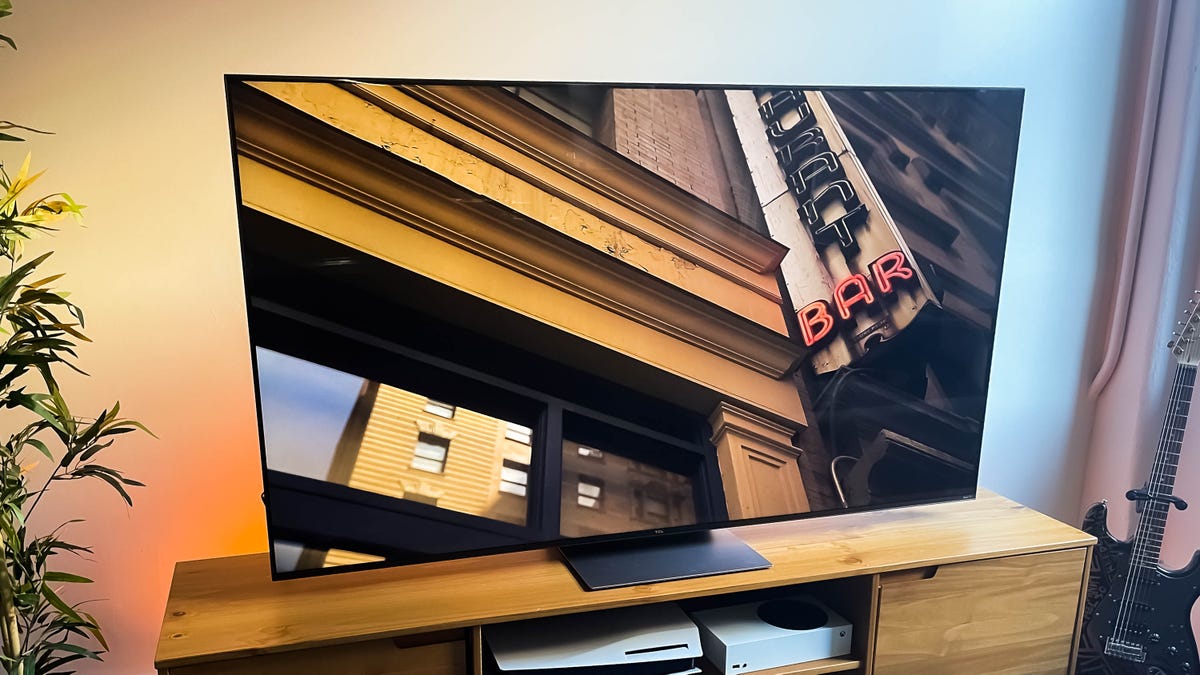
David Katzmaier/CNET
On the other hand the Hisense was visibly brighter than the TCL with similar black levels, which increased its sense of impact. The fire between the silhouettes of the king and his young queen looked more brilliant on the Hisense, and measured brighter too (806 nits compared to 627 on the TCL). Full-screen daylight, such as the sky behind the white stag, also looked brighter on the Hisense.
With less-theathical content, such as the test montage from the Spears and Munsil 4K Blu-ray, the extra brightness of the Hisense was again evident. The TCL showed just a bit less brilliance and impact, although the two were very close. In the scenes with objects against a black background black levels were basically identical between the two — inky-dark and a step better than the Vizio — but the objects themselves, like the honey dripper and peacock feather, looked brighter on the Hisense. Colors on the TCL and Hisense also looked superb, and similarly brilliant.
The Hisense, unfortunately, showed evidence of edge enhancement that I noticed in over-sharp edges of the trees and confirmed with test patterns — despite the sharpness control set to zero and relevant processing toggled off. The TCL and Vizio, properly, showed no such issues.
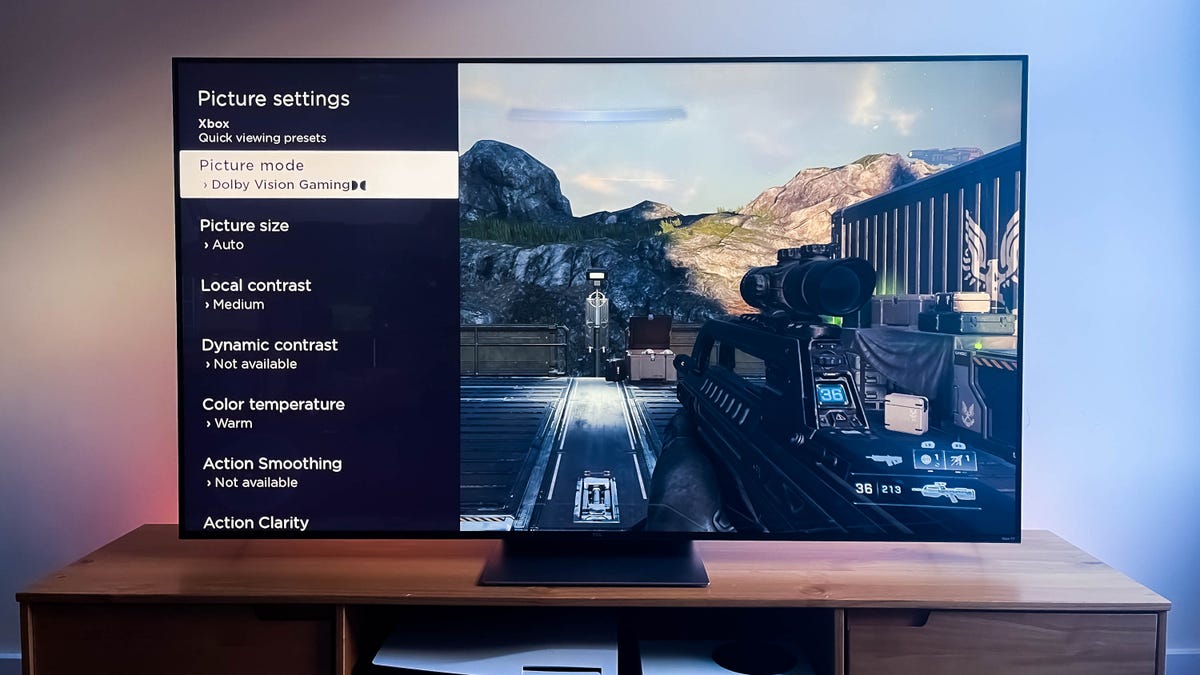
David Katzmaier/CNET
Gaming: The TCL’s game mode delivered good picture quality, and again shadow detail was a strength. When playing Mass Effect, for example, it revealed more of the dark areas than the Hisense. Overall, however, I preferred the look of the Hisense’s game mode with its brighter highlights and generally punchier image (again). Both also looked significantly more color-accurate than the Vizio, which was quite blue.
According to the information screen on my Xbox Series X the TCL supports 4K/120Hz with HDR, including full Dolby Vision gaming. I also appreciated that ALLM appeared to work well; the TV automatically switched to game mode when I connected the console. Input lag was also excellent, around 11ms for both 4K and 1080p sources. It’s worth noting that I measured similar lag in the Movie and Dark HDR modes, so if you prefer to use those rather than the game mode, you shouldn’t notice any additional lag.
Bright lighting: The TCL R655 has an impressive image under the lights as well. It can get exceedingly bright, although not significantly brighter than its predecessor, and measured dimmer than the Hisense U8H overall. That said it outshined most TVs I’ve tested however, with the exception of the significantly more-expensive Samsung QN90B.
Light output in nits
| TV | Brightest mode (SDR) | Accurate mode (SDR) | Brightest mode (HDR) | Accurate mode (HDR) |
|---|---|---|---|---|
| Samsung QN65Q90B | 2,625 | 974 | 3,316 | 1,981 |
| Hisense U8H | 1,605 | 1,605 | 1,867 | 1,867 |
| TCL 65R655 | 1,292 | 624 | 1,387 | 1,194 |
| TCL 65R635 (2020) | 1,114 | 792 | 1,292 | 1,102 |
| Vizio M65QXM-K03 | 958 | 608 | 939 | 742 |
| Samsung QN55Q60B | 549 | 343 | 540 | 514 |
| LG OLED65C2 | 413 | 389 | 812 | 759 |
The TCL’s brightest settings, “TV Brightness: Brighter” and “Picture mode: Vivid,” (or “Bright HDR” for HDR content) are terribly inaccurate. An accurate bright-room picture is easy to achieve, however. Just switch the mode to “Movie” or “Dark HDR” mode, which reduces light output but delivers a much better image.
Under bright lighting the TCL’s screen was better than the Vizio at reducing reflections and preserving black levels. IT was about the same as the Hisense.
Uniformity and viewing angle: The TCL’s screen showed no major uniformity issues. It preserved off-angle color fidelity about as well as the Hisense U8H, and slightly better than the Vizio.
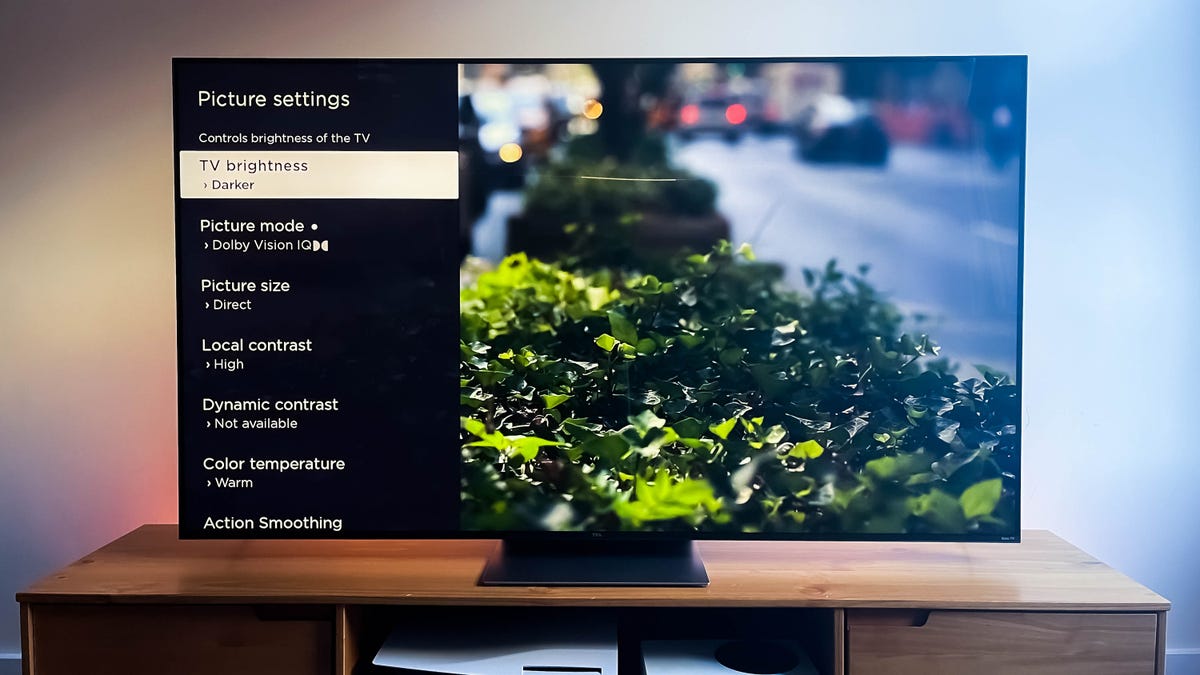
David Katzmaier/CNET
Picture settings and measurement notes
TCL’s picture settings have separate TV Brightness and Picture Mode, and both have a significant effect on image quality. For standard dynamic range sources, the TV Brightness = Darker, Picture mode = Movie setting measured the most-accurate for a dim room. For brighter rooms I’d recommend just upping the TV Brightness setting; it offers five modes from Darker to Brighter as well as a setting that adjusts brightness automatically.
For high dynamic range sources I’d stick with the TV Brightness = Brighter, Picture Mode = Dark HDR for pretty much everything. It delivers the best EOTF of any setting, better than any of the other TV Brightness settings, and also takes full advantage of the TV’s light output without sacrificing accuracy. You can get slightly brighter by choosing the Bright HDR picture mode but it’s much less accurate.
The TCL has a smoothing option that engages the Soap Opera Effect (Picture settings>Action smoothing) and happily it’s “off” in Movie and Dark HDR modes. You can also turn on LED Motion Clarity to improve motion resolution, but doing so dims the image so I left it turned-off.
Geek box
| Test | Result | Score |
|---|---|---|
| Black luminance (0%) | 0.011 | Good |
| Peak white luminance (SDR) | 1292 | Good |
| Avg. gamma (10-100%) | 2.20 | Good |
| Avg. grayscale error (10-100%) | 3.88 | Average |
| Dark gray error (30%) | 1.73 | Good |
| Bright gray error (80%) | 5.60 | Poor |
| Avg. color checker error | 3.23 | Average |
| Avg. saturation sweeps error | 2.76 | Good |
| Avg. color error | 1.89 | Good |
| 1080p/24 Cadence (IAL) | Pass | Good |
| Input lag (Game mode) | 11.27 | Good |
| HDR10 | ||
| Black luminance (0%) | 0.009 | Good |
| Peak white luminance (10% win) | 1387 | Good |
| Gamut % UHDA/P3 (CIE 1976) | 96.17 | Good |
| ColorMatch HDR error | 2.38 | Good |
| Avg. color checker error | 1.59 | Good |
| Input lag (Game mode, 4K HDR) | 10.90 | Good |
See How We Test TVs for more details and explanations of the Geek Box results.
Portrait Displays Calman calibration software was used in this review.

